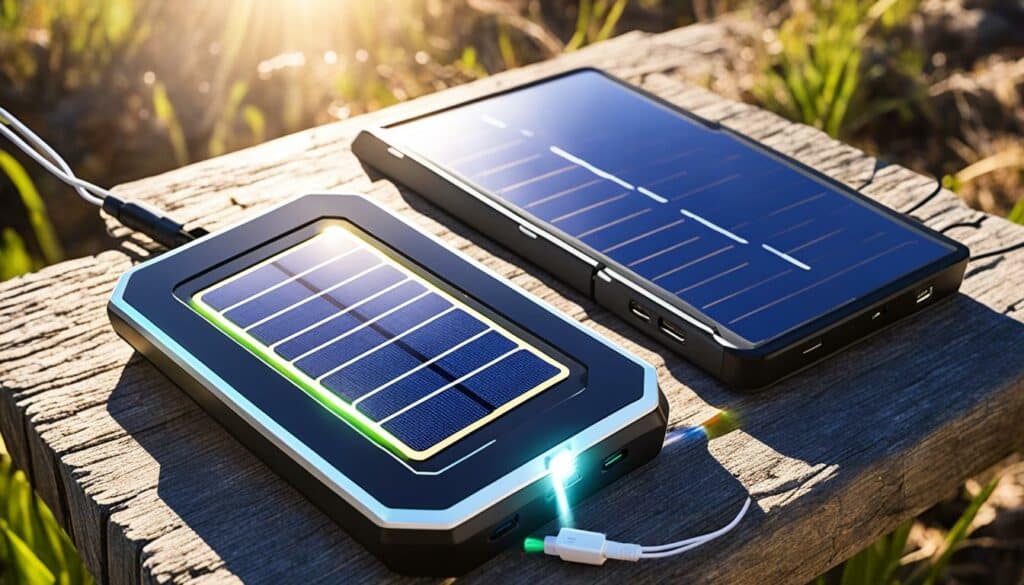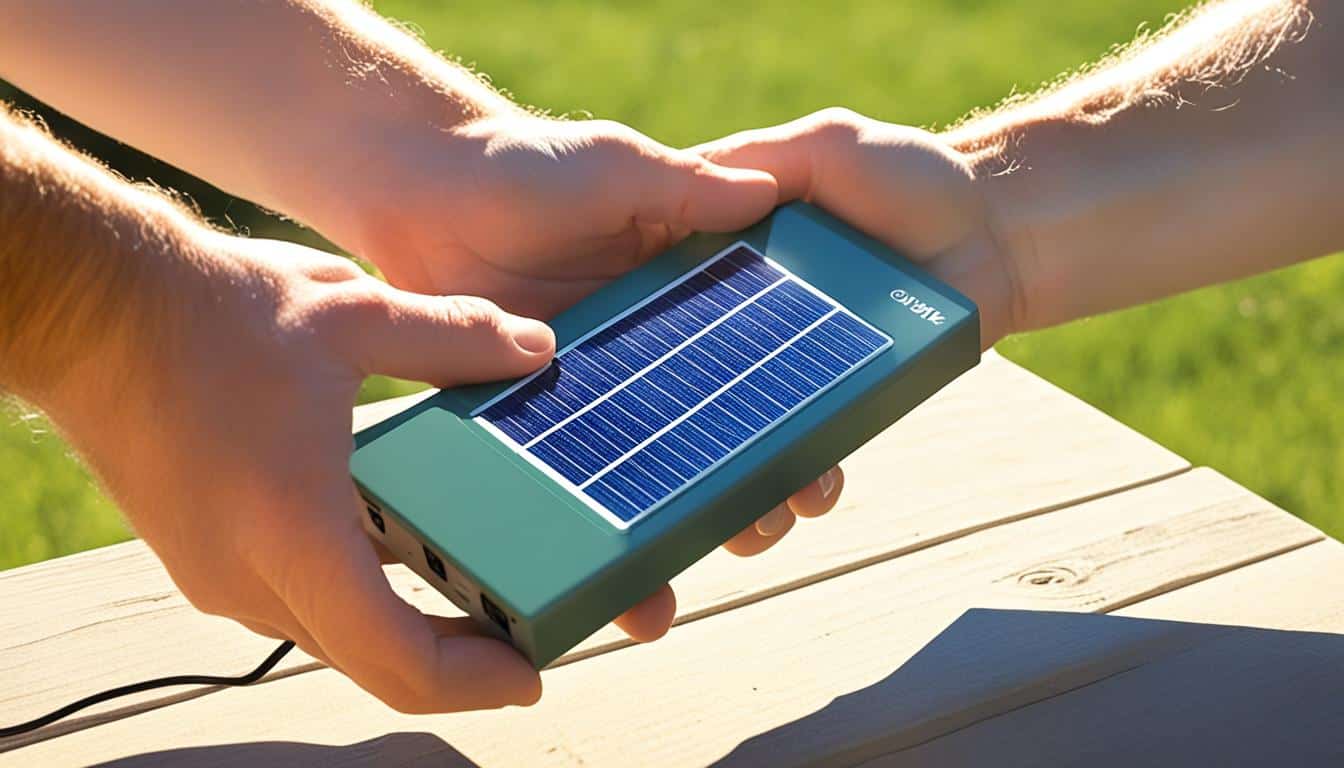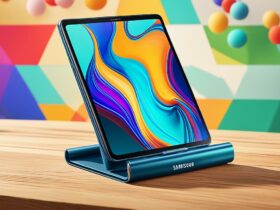Welcome to our comprehensive guide on how to charge your solar power bank properly. If you own a solar power bank, it’s important to follow best practices to ensure efficient charging, maximize battery life, and troubleshoot any potential charging issues. In this guide, we will provide you with step-by-step instructions, useful tips, and insights into different charging methods for solar power banks.
Solar power banks are convenient and eco-friendly devices that harness the sun’s energy to charge their internal batteries, which can then be used to charge various devices. By understanding the features of a power bank solar charger and using it correctly, you can enjoy its benefits in various situations, from outdoor adventures to emergency preparedness.
Key Takeaways:
- Follow best practices for efficient charging of your solar power bank.
- Maximize battery life by maintaining and recharging the battery properly.
- Understand different charging methods for solar power banks, including solar, AC, DC, and USB charging.
- Ensure safe charging by using appropriate charging equipment and avoiding common pitfalls.
- Troubleshoot any charging issues that may arise to maintain optimal performance.
Understanding Power Bank Solar Chargers
Power bank solar chargers are portable devices that combine the convenience of a power bank with the eco-friendly benefits of solar energy. These chargers are equipped with a built-in solar panel, a powerful battery, input and output ports, and a durable outer casing. They are designed to harness solar energy to charge the internal battery, which can then be used to charge various devices such as smartphones, tablets, and cameras.
The key features of a power bank solar charger include:
- A Solar Panel: The solar panel is the heart of the charger, responsible for converting sunlight into electricity.
- A Built-In Battery: The built-in battery stores the solar energy and provides power to charge devices.
- An Input Port: The input port allows you to recharge the power bank using alternative charging methods like USB or AC.
- An Output Port: The output port enables you to connect your devices and charge them conveniently.
- A Durable Outer Casing: The outer casing is designed to protect the internal components from damage, making the charger suitable for outdoor use.
Understanding the specifications of a power bank solar charger is crucial for making an informed purchase. These specifications include the solar panel’s wattage, the battery’s capacity measured in milliampere-hours (mAh), the charging efficiency, and the charging time under sunlight. It is important to consider the charging requirements of your devices and match them to the power bank solar charger’s output capacity for optimal charging performance.
“Power bank solar chargers offer a convenient and sustainable way to charge your devices on the go. By harnessing the power of the sun, you can stay connected even in remote locations without access to traditional power sources.” – Sarah Mitchell, Outdoor Enthusiast
Check out the image below to see the components of a typical power bank solar charger:
| Component | Description |
|---|---|
| Solar Panel | Converts sunlight into electricity. |
| Built-In Battery | Stores the solar energy for later use. |
| Input Port | Allows alternative charging methods. |
| Output Port | Connects devices for charging. |
| Durable Outer Casing | Protects the internal components. |
By understanding the features and specifications of power bank solar chargers, you can choose the right charger for your needs and enjoy the benefits of portable and sustainable charging.
Best Uses for Solar Power Bank Chargers
Solar power bank chargers are not only a convenient way to keep your devices powered up on the go, but they also offer a wide range of uses for various lifestyles and situations. Whether you’re embarking on a travel adventure, going camping, or preparing for emergencies, a solar power bank charger can be a valuable companion.
1. Travel
When you’re traveling, especially to remote destinations or countries with unreliable power sources, a solar power bank charger is a must-have. It allows you to charge your devices, such as smartphones, tablets, or cameras, even when you’re away from traditional charging outlets. Simply harness the power of the sun and keep your devices powered up throughout your trip.
2. Camping and Off-Grid Adventures
In the great outdoors, free from the constraints of electrical outlets, a solar power bank charger becomes essential. Whether you’re camping, hiking, or engaging in off-grid adventures, you can rely on solar energy to charge your devices and stay connected. Capture breathtaking photos, navigate with GPS, or listen to music without worrying about draining your device’s battery.
3. Sports Games and Tailgates
Heading to a sports game or tailgate party? Don’t let a dead battery ruin the fun. Bring a solar power bank charger along and never miss capturing a memorable moment or sharing it with friends. With a solar power bank, you can keep your devices charged, ensuring you’re always ready to snap photos, post updates on social media, or check scores.
4. Parties and Events
Throwing a party or attending an outdoor event? A solar power bank charger can be a lifesaver in ensuring your devices stay powered and connected. Use it to charge a Bluetooth speaker, keep your smartphone juiced up for music streaming or photo-taking, or even power decorative lights to create a festive atmosphere.
5. Emergency Preparedness
During emergencies or power outages, staying connected and having access to essential communication devices is crucial. A solar power bank charger provides a reliable and independent power source that can keep your smartphone or emergency radio powered up for emergency calls, updates, or staying informed about the situation.
6. Mobile Homes
If you live in a mobile home or RV, a solar power bank charger can be an excellent addition to your setup. It allows you to harness the sun’s energy to charge your devices, reducing reliance on traditional power sources and providing you with a sustainable and off-grid charging solution.

As you can see, solar power bank chargers offer incredible versatility for a variety of situations, making them a must-have accessory for anyone seeking power on the go. From travel and camping to emergencies and mobile homes, these chargers provide a convenient and eco-friendly way to keep your devices charged anywhere the sun shines.
How to Use a Power Bank Solar Charger
Using a power bank solar charger is a simple and efficient way to charge your devices on the go. This section will guide you through the steps of charging the battery using solar power and discharging the power to charge your devices.
Understanding how solar power works:
Solar power works by converting sunlight into electricity using solar panels. The power bank solar charger harnesses this solar energy and stores it in its built-in battery for later use.
Storing solar power:
When using a power bank solar charger, it’s important to ensure that the device is placed in direct sunlight to maximize solar power absorption. The solar panels on the charger will convert the sunlight into electricity, which will be stored in the battery.
Charging the battery:
To charge the power bank’s battery, simply place it in direct sunlight. The solar panels will start converting the sunlight into electricity, which will charge the battery. The charging time will vary depending on the intensity of sunlight and the capacity of your power bank.
Recommended charging frequency:
It is recommended to charge your power bank solar charger whenever it is not in use. This will ensure that the battery is always topped off and ready to charge your devices whenever you need them.
Discharging the power:
Once the power bank’s battery is fully charged, you can use the power to charge your devices. Simply connect your device to the power bank using the appropriate charging cable, and the power bank will start discharging its stored power to charge your device.
Importance of topping off the battery:
To maintain the battery’s health and longevity, it is recommended to top off the power bank’s battery periodically. This means charging the battery to full capacity even if it is not completely depleted. Topping off the battery regularly helps prevent battery degradation and maximizes its lifespan.
Different charging methods:
In addition to solar power, power bank solar chargers can also be charged using alternative methods such as AC charging, DC charging, and USB charging. These methods come in handy when solar power is not available or during emergencies.
By following these steps and understanding how to use a power bank solar charger, you can conveniently charge your devices using solar power while on the go.

Charging Your Solar Power Bank
When it comes to charging your solar power bank, you have a variety of options to choose from. Whether you prefer harnessing the energy of the sun or using alternative electricity sources, there are methods that suit your needs. Let’s explore the different charging methods for your solar power bank:
Solar Power Charging
Solar power charging is a popular and eco-friendly option. You can charge your solar power bank using an all-in-one solar charger or independent solar panels. Simply place the solar panels under direct sunlight and let the power bank soak up the sun’s energy. It’s a great way to utilize renewable energy and ensure your devices stay charged even in outdoor settings.
AC Charging
AC charging involves using a traditional electrical outlet to charge your solar power bank. Most power banks come with an AC adapter that allows you to plug it into a wall socket. This method is convenient when you have access to electricity and want to quickly charge your power bank.
DC Charging
DC charging is another option for charging your solar power bank. This method involves using a direct current power source, such as a car charger or a DC power outlet. It’s especially useful when you’re on the go and need to charge your power bank while driving or using a portable power source.
USB Charging
USB charging is a versatile method that allows you to charge your solar power bank using a USB cable. You can connect your power bank to a computer, laptop, or any device with a USB port. This method is convenient and widely compatible with various devices.
No matter which charging method you choose, it’s important to follow the manufacturer’s instructions for optimal performance and safety. Now that you know the different charging methods, you can choose the one that best suits your needs and enjoy the convenience of a charged solar power bank.
Discharging Your Solar Battery
Once your solar power bank is fully charged, it’s time to put its discharging capabilities to use. With a variety of options available, you can charge a wide range of devices using your power bank.
Charging Your Phone and Other Devices
Your solar power bank is equipped with USB outlets, allowing you to charge your phone and other USB-powered devices. Simply connect your device to the power bank using a compatible charging cable, and the power bank will deliver the necessary charge to replenish your device’s battery.
Whether you’re at home, on a hike, or camping in the wilderness, your solar power bank ensures that your devices stay powered up. No more worrying about running out of battery when you’re out and about!
Continuous Electricity for Larger Devices
Some power banks go beyond charging phones and offer continuous electricity for larger devices. These power banks are equipped with AC plugs or other outlets, allowing you to power up devices that require a standard electrical connection.
Imagine having continuous electricity to run a small fan during a camping trip or to keep your laptop powered up while working remotely. Your solar power bank can be a reliable source of continuous power, giving you the flexibility to stay connected wherever you go.
“Having a solar power bank with USB outlets and AC plugs has been a game-changer for me. I can easily charge my phone and even run small appliances when I’m off the grid!” – Jessica, avid outdoor enthusiast
With the ability to discharge power and charge other devices, your solar power bank offers convenience and reliability. Whether you’re on a rugged adventure or simply need to charge your phone on the go, your power bank has got you covered.
Next, let’s explore how to maximize the battery life of your solar power bank.
Maximizing Solar Power Bank Battery Life
When it comes to your solar power bank, maximizing battery life is key. By understanding important factors such as battery capacity, battery lifespan, amp-hours, watt-hours, and life cycles, you can ensure optimal performance and longevity.
Battery capacity refers to the amount of energy your power bank can store. A higher capacity means more power available for charging your devices. When choosing a solar power bank, consider your charging needs and select a capacity that suits your requirements.
Battery lifespan is another crucial aspect to consider. Over time, batteries naturally deteriorate and require replacement. Understanding the lifespan of your solar power bank’s battery will help you plan for future replacements and ensure uninterrupted service.
Amp-hours (Ah) and watt-hours (Wh) are important units of measurement for battery capacity and energy storage. These values provide insights into the amount of charge your power bank can hold and deliver. Consider these values when comparing different models and selecting the one that suits your needs.
Life cycles refer to the number of times a battery can be fully charged and discharged before it starts losing its capacity. The more life cycles a battery can endure, the longer it will last. Check the specifications and reviews of solar power banks to ensure you choose one with a high number of life cycles.
Online reviews can also be a valuable resource when it comes to determining the battery performance of solar power banks. By checking reviews from other users, you can gain insights into the actual battery life and performance of specific models.
Maintaining battery life is essential for prolonging the lifespan of your solar power bank. Follow these tips to maximize battery life:
- Avoid exposing your power bank to extreme temperatures, as it can negatively impact battery performance.
- Regularly recharge your power bank, even if you’re not actively using it. This will help maintain the battery and ensure it’s ready when you need it.
- Avoid letting your power bank sit idle for long periods without use. Continuous discharging and recharging helps optimize battery performance.
- Top off your battery regularly. Instead of waiting for the power bank to fully discharge before recharging, consider charging it partially or topping it off whenever possible.
By following these tips and understanding the important factors that contribute to solar power bank battery life, you can ensure long-lasting performance and dependable charging for your devices.
| Factor | Description |
|---|---|
| Battery Capacity | The amount of energy your power bank can store |
| Battery Lifespan | The expected lifespan of your power bank’s battery |
| Amp-hours (Ah) | A unit of measurement for battery capacity |
| Watt-hours (Wh) | A unit of measurement for energy storage |
| Life Cycles | The number of times a battery can be fully charged and discharged before losing capacity |
| Online Reviews | Feedback from other users regarding battery performance and overall satisfaction |
Conclusion
Properly charging your solar power bank is crucial in order to maximize its battery life and ensure efficient usage. By following the instructions and tips outlined in this guide, you can charge your solar power bank safely and effectively. It is important to choose the right charging methods, maintain the battery, and troubleshoot any charging issues that may arise.
To charge your solar power bank, consider using various methods such as solar power charging, AC charging, DC charging, or USB charging. Solar power charging can be done with an all-in-one solar charger or independent solar panels. Additionally, alternative electricity sources like AC or DC can also be utilized to charge the power bank.
Remember to always prioritize the maintenance of your solar power bank’s battery. Taking measures to maintain battery life, such as recharging it regularly and avoiding idling, will help prolong its lifespan. Checking online reviews for battery capacity, amp-hours, watt-hours, and life cycles can also provide valuable insights.
With the knowledge gained from this guide, you can confidently charge your solar power bank and harness the power of the sun to keep your devices running no matter where you are. By following these best practices, you can ensure that your solar power bank remains a reliable and efficient source of portable power.
FAQ
How do I charge my solar power bank?
To charge your solar power bank, you can use solar power charging, AC charging, DC charging, or USB charging methods.
Can I charge my solar power bank using solar panels?
Yes, solar power charging can be done using either an all-in-one solar charger or independent solar panels.
What other methods can I use to charge my solar power bank?
Apart from solar power charging, you can also charge your power bank using AC charging, DC charging, or USB charging.
How do I use the power from my solar power bank to charge my devices?
You can use the power from your solar power bank to charge your devices by connecting them to the power bank’s USB outlets or other available outlets like AC plugs.
How can I maximize the battery life of my solar power bank?
To maximize the battery life of your solar power bank, you should consider factors such as battery capacity, battery lifespan, amp-hours, watt-hours, and life cycles. It is also important to check online reviews, maintain the battery, recharge it regularly, and avoid leaving it idle for long periods.
What should I do if I encounter charging issues with my solar power bank?
If you experience charging issues with your solar power bank, you can try troubleshooting the problem by checking the charging connections, ensuring the solar panel is exposed to adequate sunlight, and verifying that the power bank is compatible with your devices.







